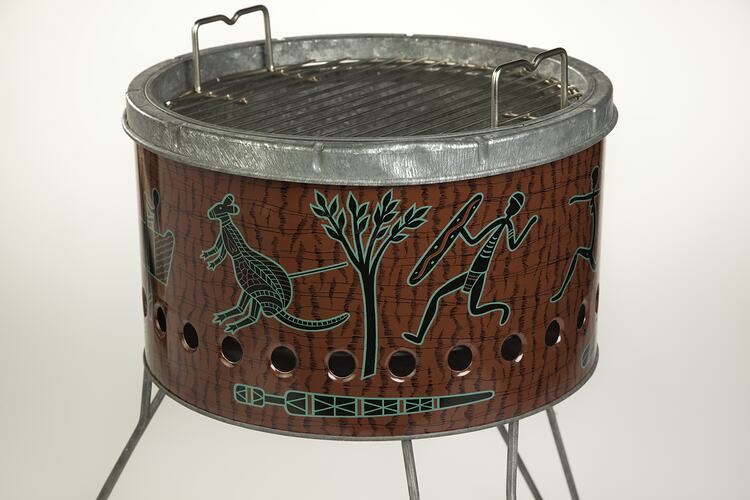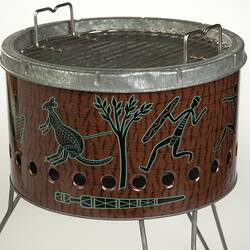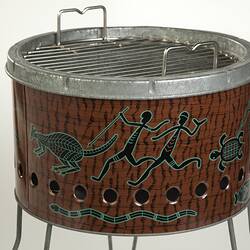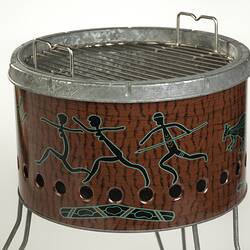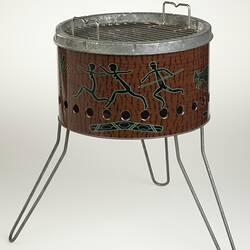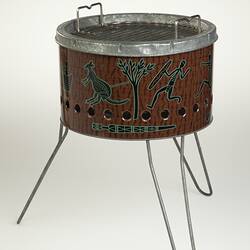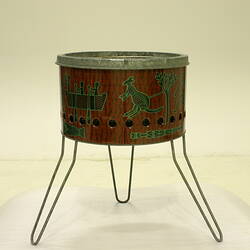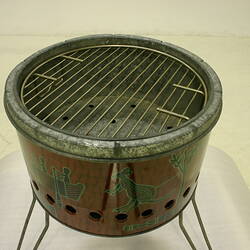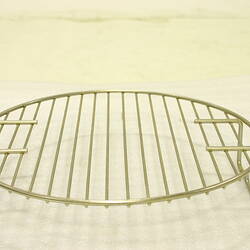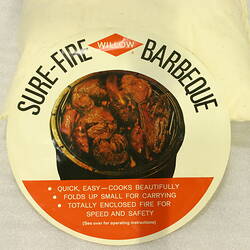Summary
Note: This object includes elements appropriated from First Peoples culture and heritage and stereotypical depictions. Such cultural appropriation and stereotyping is not condoned by Museums Victoria which considers it to be inappropriate, even racist. Historical distance and context do not excuse or erase this fact.
Alternative Name(s): Barbeque
Willow, Sure Fire BBQ with First Peoples motifs, made in Melbourne in 1970. It comprises a brown circular drum on three fold-out wire legs. with depictions of First Peoples men and women hunting kangaroos, turtles, A central metal container and wire grilling rack sit inside the drum.
The 'Corroboree' design barbecue was made in 1970, and was manufactured for one season only. Between 5,000 and 8,000 units were made. It did not sell well, so there was no repeat production. The design is appropriated from First Peoples' culture and the following description by manufacturers of the product's motivation is offensive to First Peoples, who state the choice of design was 'due to the go anywhere portability of the bbq and its ability to be used anywhere. We likened this to Aboriginal culture'.
Willow Ware began as a partnership between Ralph and Richard Wilson in 1887. They established the Wilson Bros in 1889 in Flemington before moving to North Melbourne. They began by making tinned plate tea and biscuit canisters. Later they printed metal kitchenware with the blue willow pattern, under the Willow brand, a name they applied to the company in 1965. Willow Ware Australia Pty Ltd is currently located in Tullamarine.
Physical Description
A small metal barbecue. Circular brown drum with motifs of men and women hunting kangaroos, turtles, etc. Pierced holes around base of body. The BBQ has 3 wire legs that fold out. A central metal container and wire grilling rack sits inside body.
Significance
Willow Ware is an example of a company that began operating from the backyard of the family home, and has grown into a company exporting to over fifty countries. It began as a family partnership in the late nineteenth century, and has adapted to changing needs and technologies to become a company employing over one hundred people in the early twenty-first century. They have won a Commonwealth Export Award (1972), design awards for their microwave cookware range (1987) and an award for manufacturing excellence (1987).
More Information
-
Collecting Areas
-
Acquisition Information
Purchase
-
Manufacturer
Willow Ware Australia Pty Ltd, Melbourne, Victoria, Australia, circa 1970
Email correspondence between curator and David Aldridge, Willow Wares Pty Ltd, 09-02-2005. -
Classification
-
Category
-
Discipline
-
Type of item
-
Overall Dimensions
39.37 cm (Height), 28.57 cm (Outside Diameter)
-
Keywords
Indigenous Cultures, Barbecue Cookers, Barbecue Equipment, Cooking Equipment, Domestic Life, Indigenous Issues
